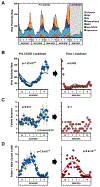Effect of the COVID-19 Lockdown on Asthma Biological Rhythms
- PMID: 35319293
- PMCID: PMC9010369
- DOI: 10.1177/07487304221081730
Effect of the COVID-19 Lockdown on Asthma Biological Rhythms
Abstract
Asthma has a striking temporal character, in which time-of-day, patient age, and season each influence disease activity. The extent to which rhythms in asthma activity reflect exposure to specific disease triggers remains unclear. In this study, we examined how virus mitigation strategies enacted during the COVID-19 pandemic ("lockdown measures") affected rhythms in asthma clinical activity in children. To this end, we retrospectively analyzed asthma clinical presentations in children aged <18 years to our regional academic medical center, comparing 4 years of medical records prior to COVID-19 lockdown measures with the 12 months immediately after the institution of such measures. We correlated these data to positive viral test results, febrile seizures, and allergic clinical surrogates (allergic reaction visits and Emergency Department [ED] antihistamine prescriptions, respectively) over the same time frame. In the 12 months following the institution of the COVID-19 lockdown, positivity rates for common respiratory viruses dropped by 70.2% and ED visits for asthma among children dropped by 62% compared to pre-COVID years. Lockdown suppressed seasonal variation in positive viral tests and asthma ED visits, while diurnal rhythms in asthma visits were unchanged. Asthma seasonality correlated most strongly with rhinovirus positivity both before and after the institution of COVID lockdown measures. Altogether, our data support a causal role for viruses in driving seasonal variability in asthma exacerbations in children.
Keywords: COVID-19; asthma; biological rhythms; seasonality; viruses.
Conflict of interest statement
CONFLICT OF INTEREST STATEMENT
The authors have declared that no conflict of interest exists.
Figures




References
-
- Carpaij OA, Burgess JK, Kerstjens HAM, Nawijn MC, and van den Berge M (2019) A review on the pathophysiology of asthma remission. Pharmacol Ther 201:8–24. - PubMed
-
- Carpaij OA, Nieuwenhuis MAE, Koppelman GH, van den Berge M, Postma DS, and Vonk JM (2017) Childhood factors associated with complete and clinical asthma remission at 25 and 49 years. The European respiratory journal 49. - PubMed
-
- Cohen HA, Blau H, Hoshen M, Batat E, and Balicer RD (2014) Seasonality of asthma: a retrospective population study. Pediatrics 133:e923–932. - PubMed
-
- De Marco R, Locatelli F, Cerveri I, Bugiani M, Marinoni A, Giammanco G, and Italian Study on Asthma in Young Adults study g (2002) Incidence and remission of asthma: a retrospective study on the natural history of asthma in Italy. The Journal of allergy and clinical immunology 110:228–235. - PubMed
Publication types
MeSH terms
Grants and funding
LinkOut - more resources
Full Text Sources
Medical

